How Does Dropshipping Work – Everything You Need To Know
How does dropshipping work? It’s time to find out
Ever wondered about the magic behind dropshipping? Brace yourself as I unravel the mysteries and intricacies of this unique business model.
If you’re contemplating diving into the world of dropshipping or are already navigating its waters, you’re in for a treat!
In this blog article, I delve into the specifics of dropshipping, laying out its advantages and disadvantages and providing essential insights before you embark on your own dropshipping journey.


Table of Contents
- What Is Dropshipping?
- How Does Dropshipping Work?
- Dropshipping Advantages
- The No. 1 Tool for all dropshippers – now with AI
- Disadvantages of Dropshipping
- Best Dropshipping Apps To Scale Your Dropshipping Business
- Top Dropshipping Suppliers To Start With
- How To Start Dropshipping As A Beginner? My Process
- Other Things To Consider When Learning How Does Dropshipping Work?
- FAQs- How Does Dropshipping Work?
- 1. Is dropshipping legal?
- 2. Is dropshipping profitable?
- 3. What are some dropshipping product ideas?
- 4. Do I need to register a business entity to dropship?
- 5. Is Dropshipping Dead?
- 6. Can I Get Rich With Dropshipping?
- 7. Can I Start Dropshipping With No Money?
- 8. How to Create My Dropshipping Store?
- 9. Can I Start a Dropshipping Business As a Teen?
- 10. What Is The Average Dropshipping Profit Margin?
- How Does Dropshipping Work?
What Is Dropshipping?
Dropshipping is a retail fulfillment method where a store doesn’t keep the products it sells in stock.
Instead, when you sell a product, you purchase the item from a third party (usually a wholesaler or manufacturer) and have it shipped directly to the customer.
As a result, the merchant never sees or handles the product.
👉 Learn How To Start An Online Store Without Inventory In 2024.
How Does Dropshipping Work?
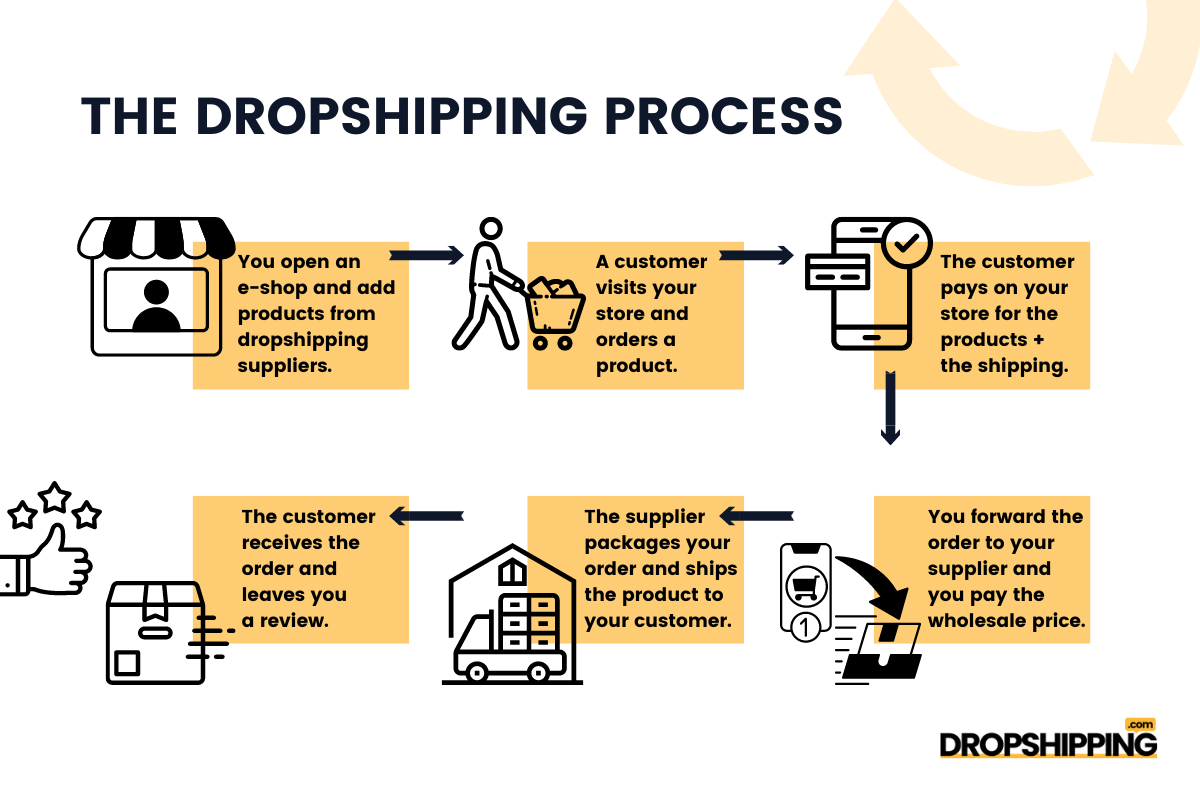
To explain how dropshipping works, let’s break it down into simple steps:
- First things first, set up your own online store or put your products on a marketplace.
- Team up with a dropshipping supplier or wholesaler—they’re the folks who handle the shipping for you.
- Pick the products you want to sell from their list and showcase them on your store.
- When someone orders from your site and pays up, just shoot the order details over to your supplier.
- Your supplier takes care of the nitty-gritty—packing, shipping, all that jazz—straight to your customer’s doorstep. No need for you to worry about storing stuff or shipping hassles.
- You pay the supplier the wholesale price for the products and pocket the difference between that and what your customer paid—that’s your profit.
- If you’ve added that special flair, your customers get their products directly from the supplier, with your personal touch (branding and packaging). And the best part? It’s all automated, thanks to some handy software. Easy peasy!
👉 Discover Print On Demand Vs Dropshipping: Which One To Start?
Dropshipping Advantages
1. Lower Start-Up Costs
This advantage is largely considered to be the biggest positive when starting a dropshipping business.
Simply put, it’s the way for anyone to start their own online store without having to spend huge amounts of money on warehousing and other expenses that come hand-in-hand with this.
Thus, traditional retailing means you must have the money in order to start purchasing inventory. On the other hand, Dropshipping is a way for you to avoid this complication.
So, using dropshipping, a seller has no need to spend any money on inventory until they have made a sale.
Thus, the money from all sold items comes from the buyer, without tapping into your own budget. Because of this, nothing can stop you from setting up your online store almost immediately, with minimum to no starting money.
Also, on some platforms, you can set up an initial store without having to pay at all. Since these platforms usually don’t provide you with a larger customer base, this is viewed as a temporary rather than a permanent option.
💡 Tip: Read about Can You Use Upwork for Dropshipping? – Build With Freelancers.
2. Fairly Easy To Run
When selecting the dropshipping model of running a business, you eliminate the hustle of handling any inventory. This makes running any type of online store much easier because you don’t need to take care of the following obligations:
- Finding and operating a warehouse
- Shipping
- Keeping track of inventory you have in stock
- Taking care of returns
- Receive and account for new items in stock
👉 Discover the Dropshipping Success Rate: How To Be Succesful In Dropshipping.
For example, many dropshipping suppliers, like AutoDS help you handle all these processes automatically. 👇
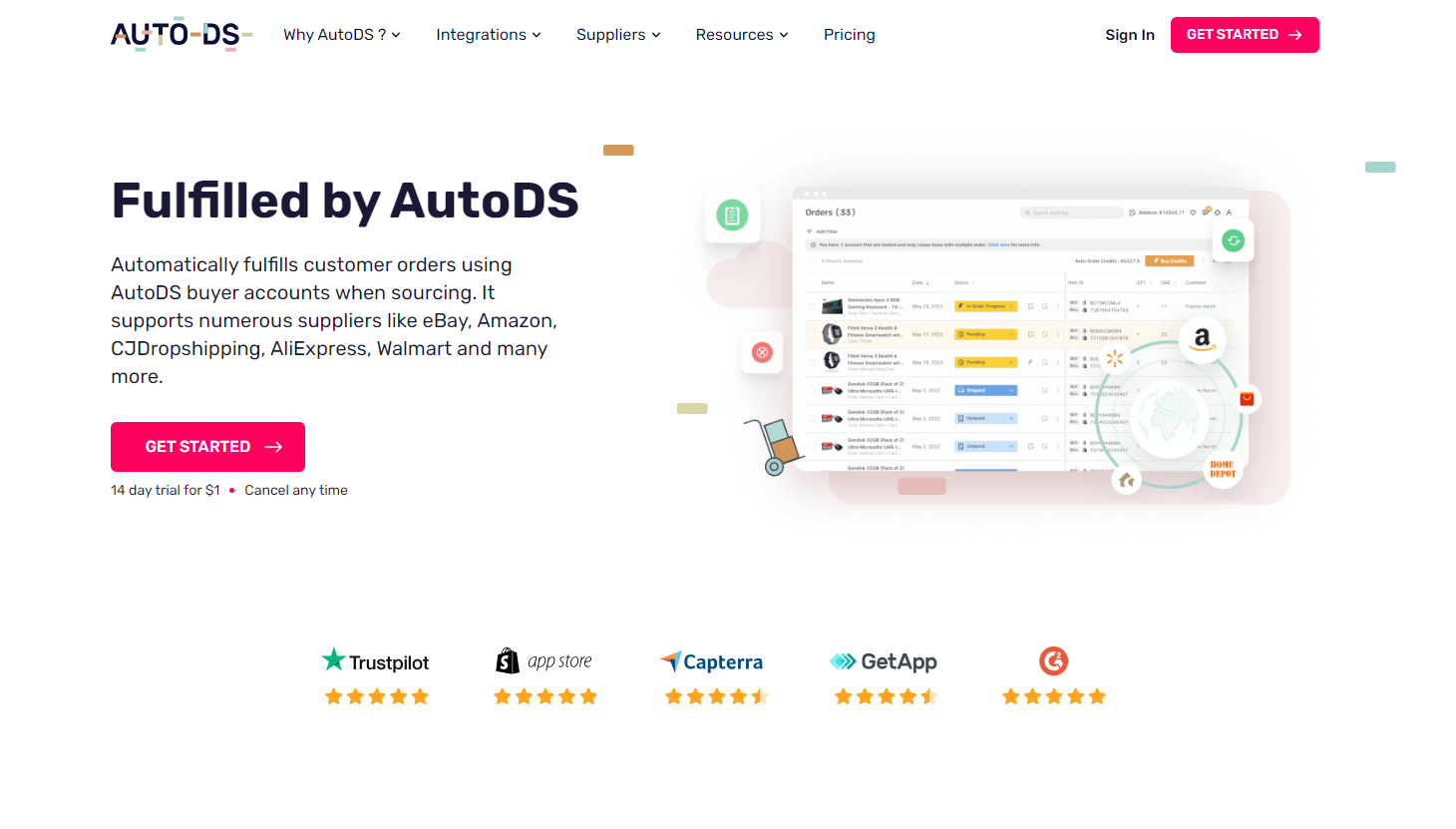
3. Fewer Expenses
To start and run your own dropshipping business, you need nothing more than a laptop connected to the Internet. Here you can learn how to earn passive income with the dropshipping business model.
So, your expenses in some cases may be lower than $100 monthly, at least at the early stages of your business.
As your online store develops, the expenses will get higher, yet it won’t be as much in comparison to owning a brick & mortar store or an online store stocking their items.
👉 Learn How Much Does It Cost To Start Dropshipping In 2024?
4. Location Flexibility
As mentioned before – all you need to run your online business is a fairly good laptop with an available Wi-Fi connection at all times.
Your job is to communicate with customers and suppliers, so it can be done virtually from anywhere in the world. It’s the perfect option if your online store is just a way for you to make extra money while working a full-time job, or if you prefer living as a digital nomad.
👉 Check out How To Make Money From Home – 30+ Ideas & Examples.
5. Versatile Product Selection
You don’t need to stock the items, which means you can provide customers with as many options as you wish, provided your supplier (or suppliers) have them in stock.
You just place as many items as you see fit on your website and try to sell them.
This way, you can see which items sell and which don’t. And in case an item doesn’t sell well, don’t worry. So, you won’t be left with tons of the product, wasting storage space with no way of getting rid of it for profit in the foreseeable future.
Also, because your product selection is quite flexible, you can conduct experiments with little to no risks, trying to sell items that are new to the market or simply selling items that stay popular for a short period of time.
This includes seasonal inventory (swimsuits, winter boots, gardening supplies) and other items used in references to popular culture.
Thus, your safe option is to always go with mass-market products:
- Jewelry Products,
- Fashion Products,
- Pet Products And Accessories,
- General Clothing Suppliers,
- Outdoor & Tactical Gear,
- Best Health and Beauty Dropshipping Products, and so on.
6. Easier Growth
Starting a regular online store demands tons of effort, but the results aren’t always as impressive. It often means working harder and putting in more money.
On the flip side, with dropshipping, most of the heavy lifting is done by the suppliers. This allows you to grow your business at a manageable pace, unlike traditional stores with stocked inventory.
By opting for dropshipping, you avoid unnecessary stress and extra work. You can channel your energy into building top-notch customer service, letting the suppliers handle order processing and shipping without your direct involvement.
These perks make the dropshipping model a hit among new online store owners. However, it’s not flawless, and it’s crucial to understand its downsides before deciding. By now, you’ve got the basics of how dropshipping operates.
Disadvantages of Dropshipping
1. Lower Net Profit
You already know how easy it is to start a dropshipping business compared to traditional retailing.
However, if you work in a more competitive industry, you’ll face a common issue: people selling the same products as you at the lowest possible price, making minimal profits.
Since it costs them nothing to start this business and doesn’t take much effort to run, they can afford to make minimal profits just to beat the competition.
Even if these resellers have poor customer service and less user-friendly websites, they’ll still attract customers simply because their prices are much lower.
Therefore, if you choose a highly competitive industry for dropshipping, your net profit won’t reach its full potential because merchants lower their prices to increase sales.
So, it’s highly advisable to research niches with less competition in your selected area of business.
👉 Discover How Dropshipping Stores Lose Money? (A Guide To Win In 2024).
2. Keeping Track Of Inventory
This was already covered as one of the advantages of dropshipping since you don’t need to keep track of the inventory.
However, this can also prove to be a huge disadvantage of dropshipping, because you have to trust others to do a good job of tracking what’s available in stock. And since your suppliers will work with more than one reseller, their stocks change drastically every day.
However, there are those which have the best technology to keep track of inventory, allowing you to synchronize with your website, so as to always be informed about any stock changes.
But if these plugins aren’t available, you can find yourself in a tricky situation where your customers are left very disappointed when they don’t end up getting the goods listed in stock on your website.
Thus, they have to wait for these items to be available in stock again or get a refund.
For example, if you want to track your inventory, I recommend you try Inventory Source. 👇

3. Shipping Problems
Same as with stocking, not taking care of shipping is actually one of the advantages of dropshipping. Yet, you can still encounter some problems along the way.
As the owner of a dropshipping store, you are likely to work with more than one supplier. So, it means that if your customers choose to order several items from your store, those items can all come from different warehouses, i.e. suppliers.
It won’t be a wise move to make the customers pay three times the shipping costs because of this, so they’ll probably think it isn’t fair and it’s highly unlikely for them to come back to your store.
Thus, your best option is to find a balanced price you’ll charge for shipping, even if sometimes you end up losing some money on it or vice versa.
Having different suppliers can also cause problems for your customers when tracking orders because multiple tracking numbers can cause confusion.
This can also come up when trying to resolve an issue with products or tracking because if any of your customers gets you the wrong tracking or order number, it might as well confuse everyone in the process.
4. Problems With Suppliers
In the dropshipping arena, challenges are part of the game. However, mistakes, whether technical or in communication with suppliers, are unavoidable. When these issues arise, customers point fingers at you, necessitating that resolution becomes your responsibility.
Even seasoned professionals make mistakes, and the risk is further heightened by poor communication with suppliers. Subpar suppliers introduce problems such as packaging issues, lost shipments, or stock discrepancies. The question is, are you ready to take the blame for factors beyond your control?
As a dropshipper, be prepared for various challenges involving diverse people and suppliers. Thus, working with different suppliers means navigating distinct systems for order processing, accounting, and invoicing.
Success in dropshipping ultimately hinges on making wise supplier choices. These suppliers and their systems are pivotal to your journey in the dropshipping realm.
Best Dropshipping Apps To Scale Your Dropshipping Business
Since I explained how does dropshipping work, I will now list the best apps to use for your dropshipping business.
Best Apps for Finding Winning Products
Sell The Trend
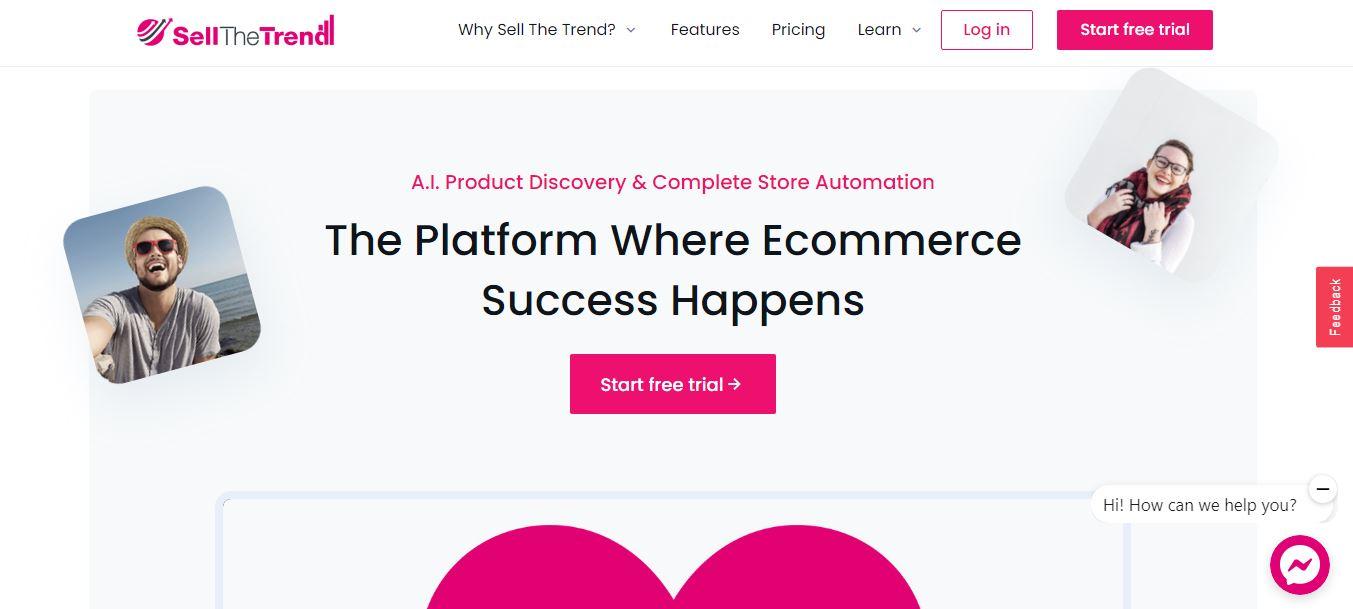
Sell The Trend is a valuable resource for identifying successful dropshipping products using advanced data-driven predictive A.I. technology. It offers trending products, automation software, a robust marketing toolbox, and introduces Sell The Trend Shops, allowing users to set up a dropshipping store in just 5 minutes.
Key Features
- Product Explorers
- The NEXUS
- Store Intelligence
- Marketing Tools
- Store Automation Software
- USA Shipping
- Success Academy
- Tutorials
- Facebook Course
- Custom Stores
➡ Pricing
Sell The Trend offers two pricing options starting at $39.97/month, along with a 7 Day Free Trial.
Minea

Minea stands out as the most advanced solution for discovering successful products and advertisements. It has gained immense popularity among dropshippers, marketers, and influencers, thanks to its user-friendly interface, availability on multiple social media platforms, and affordable pricing.
Moreover, Minea’s ad spy feature is unparalleled, boasting the most extensive collection of e-commerce ads for Facebook, Pinterest, and Minea Tik Tok ads, making it the ultimate ad spying tool.
Key Features
- Minea Products
- Minea Facebook & Instagram Ad Spy
- Minea Influencer Marketing
- Minea Tik Tok Ad Spy
- Minea Pinterest Ad Spy
- Minea Shops
Pricing
Minea offers free and paid pricing plans, starting at $49/month.
Best Apps for Finding Dropshipping Suppliers
Dropshipping.com – The Supplier Directory
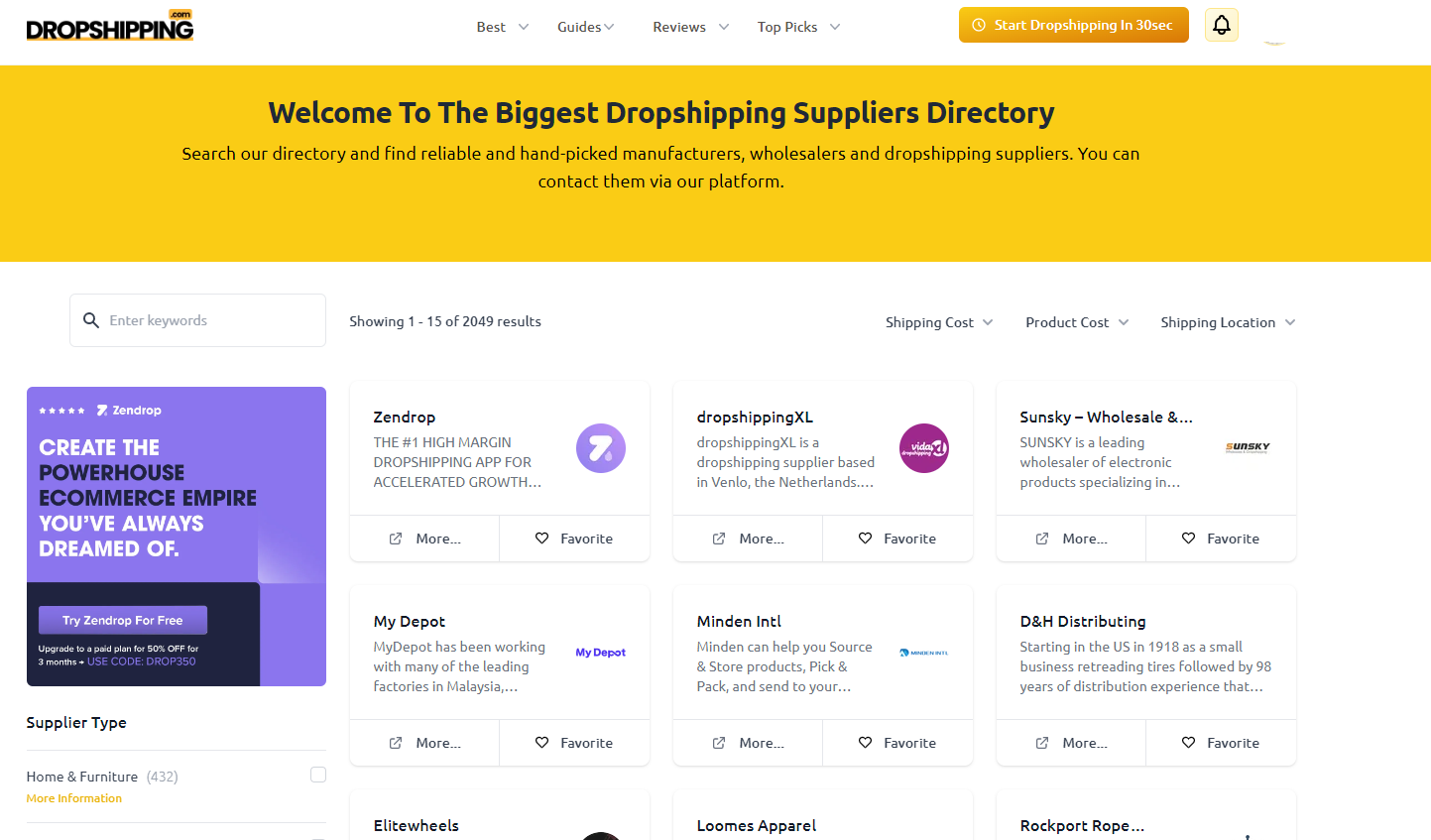
Dropshipping.com has a vast supplier directory with over 2000+ dropshipping suppliers. You can list suppliers based on category, niche, or other filters such as shipping costs, location, and product costs.
The best part? It’s totally free!
Moreover, you can request the Dropshipping.com team to contact the suppliers for you.
AutoDS
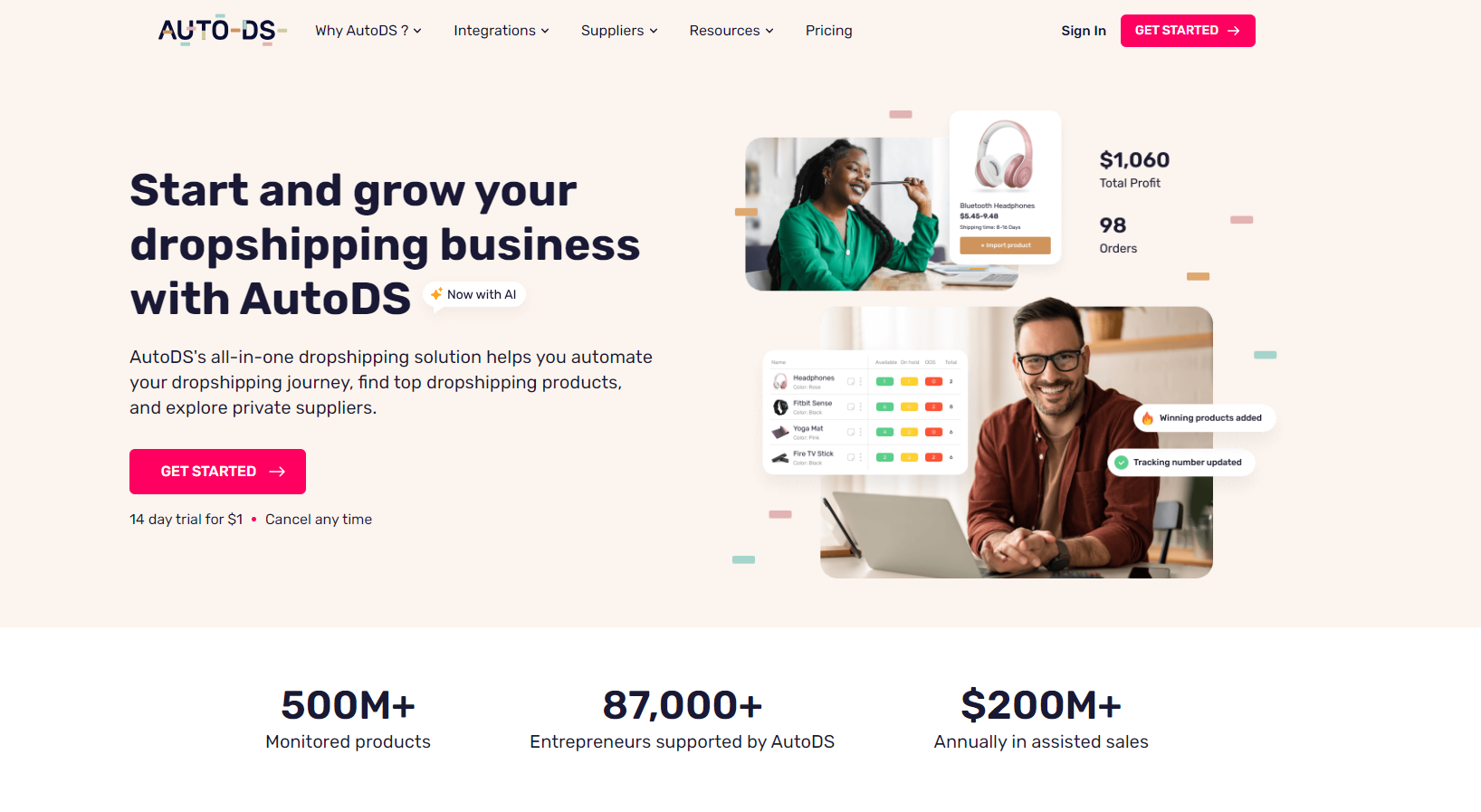
AutoDS serves as your go-to buddy for dropshipping, collaborating with big names like AliExpress, Amazon, Wayfair, CJDropshipping, and more.
It provides access to a massive collection of 500 million trendy products from trusted suppliers.
AutoDS is not just a middleman; it’s also a dropshipping supplier with a warehouse in China, ensuring faster shipping and better product quality. You can get access to their database for only $1 and enjoy a 14-day trial.
Best Apps for Building Your Dropshipping Store
Shopify

Shopify is among the most popular eCommerce platforms, featuring a simple drag & drop editor for designing your store. It offers the ability to effortlessly create an online store with customizable themes, product listings, and payment options.
So, since you know how dropshipping work, this tool is a must.
Moreover, Shopify seamlessly integrates with over 100 payment gateways, including popular options like PayPal, making it simple for dropshippers to accept payments from their customers.
The most exciting aspect is that Shopify boasts an extensive app store with a vast selection of apps specifically designed to support dropshipping businesses.
👉 Check out Is Shopify Legit in 2024? +6 Common Shopify Scams.
Pricing
Shopify offers three main pricing plans, starting at $32/month, and up to $399/month. Also, it offers a 14-day free trial.
WooCommerce
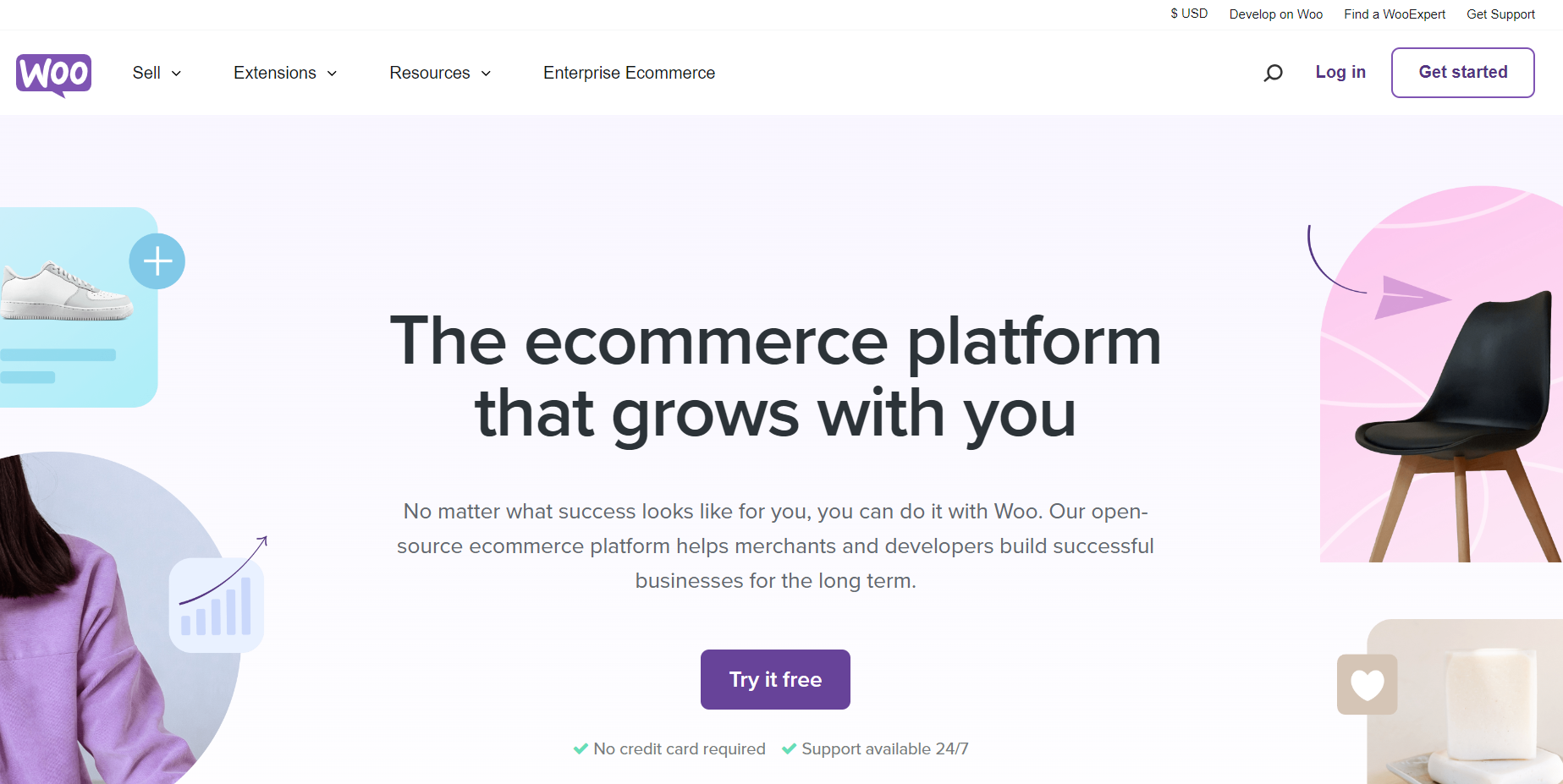
WooCommerce functions as a WordPress theme and plugin that enables you to establish and oversee an online business. By integrating the WooCommerce theme into your WordPress site, you can promptly establish an e-commerce store.
Moreover, this plugin empowers you to create compelling landing pages for your online store, import products from various suppliers like AliExpress, and make necessary adjustments until you achieve the desired outcomes.
Once your products commence selling, you can seamlessly manage order fulfillment through WooCommerce and ensure timely delivery to your valued customers.
👉 Read my review about Dropshipping WooCommerce: Everything You Need To Know About WooCommerce Dropshipping.
Pricing
WooCommerce and WordPress are both FREE to use. However, there are still some costs associated with WooCommerce like web hosting and domain registration, and they vary.
Best Tools for Marketing Your Dropshipping Business
MailChimp
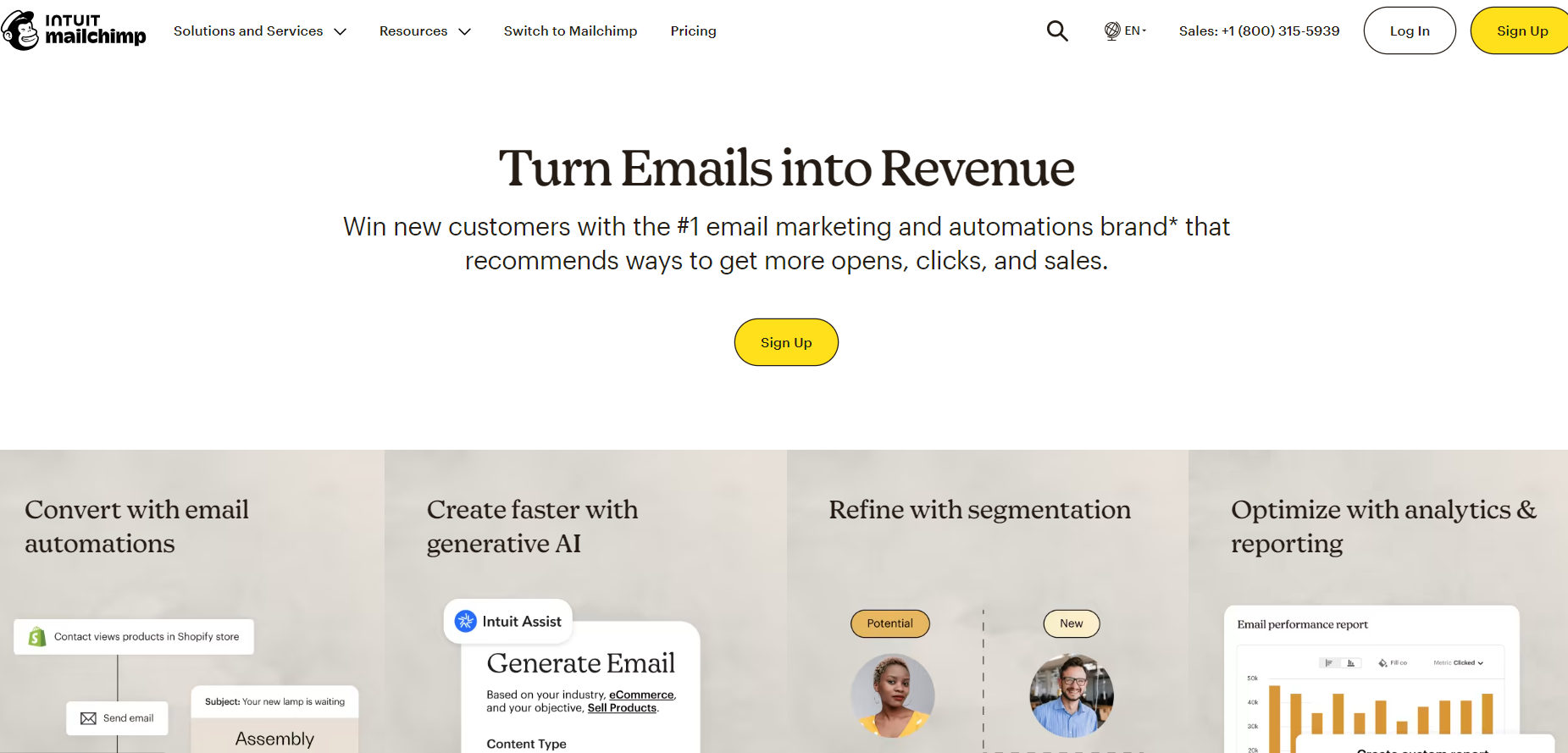
MailChimp is a great tool to develop, automate, and optimize your e-mail marketing campaign. By using it, you can ease your work thanks to its features like e-mail creation and scheduling.
So, since you know how dropshipping work, this tool is a must.
What makes MailChimp an excellent e-mail marketing tool is its smart recommendations feature, providing you with important audience insights to optimize your marketing efforts.
Pricing:
MailChimp offers four pricing plans to customers starting at $6.50 per month for 500 contacts.
Facebook Ads

Want to promote your dropshipping business on Facebook and Instagram? Then, Facebook Ads can be a good starting point for your social media marketing. It is one of the best and most popular e-commerce marketing tools for social media advertising.
With Facebook Ads, you can choose your objective, select your audience, set your budget, decide where you want to run your ads, track how well your campaigns are performing, etc.
Pricing:
As you probably know, this is a flexible, affordable marketing tool. In short, the costs differ, depending on how many ads you want to run.
Top Dropshipping Suppliers To Start With
As you already know how dropshipping work, you understand the importance of suppliers. Therefore, here I will list the top dropshipping suppliers to start with.
BrandsGateway

BrandsGateway serves as the bridge connecting dropshippers and wholesalers globally with popular industry brands.
Offering a diverse array of products from over 100 well-known brands like Armani, Calvin Klein, and Gucci, they are a dependable choice for a wide range of offerings, including clothing, shoes, jewelry, and accessories.
For wholesale clothing in NY, BrandsGateway ensures swift international delivery in 1-7 days through reliable carriers like UPS, FedEx, or DHL, with shipping rates starting at just €15 per order. They also provide a 7-day return policy.
Also, BrandsGateway seamlessly integrates with major dropshipping platforms like Shopify, WooCommerce, Wix, and Shift4Shop, simplifying tasks such as order processing, product import, and inventory updates.
In terms of pricing, subscription-based plans vary depending on the ecommerce platform.
Zendrop

Zendrop is an e-commerce platform linking reliable suppliers with online retailers and dropshipping stores.
With a catalog of 1 million diverse products across categories like fashion, home, electronics, and more, Zendrop offers fully custom packaging and various shipping options.
Also, Zendrop’s shipping times and fees vary depending on the destination and chosen shipping option. They offer three pricing plans, including a free plan and two paid plans at $49/month and $79/month.
Sunrise Wholesale
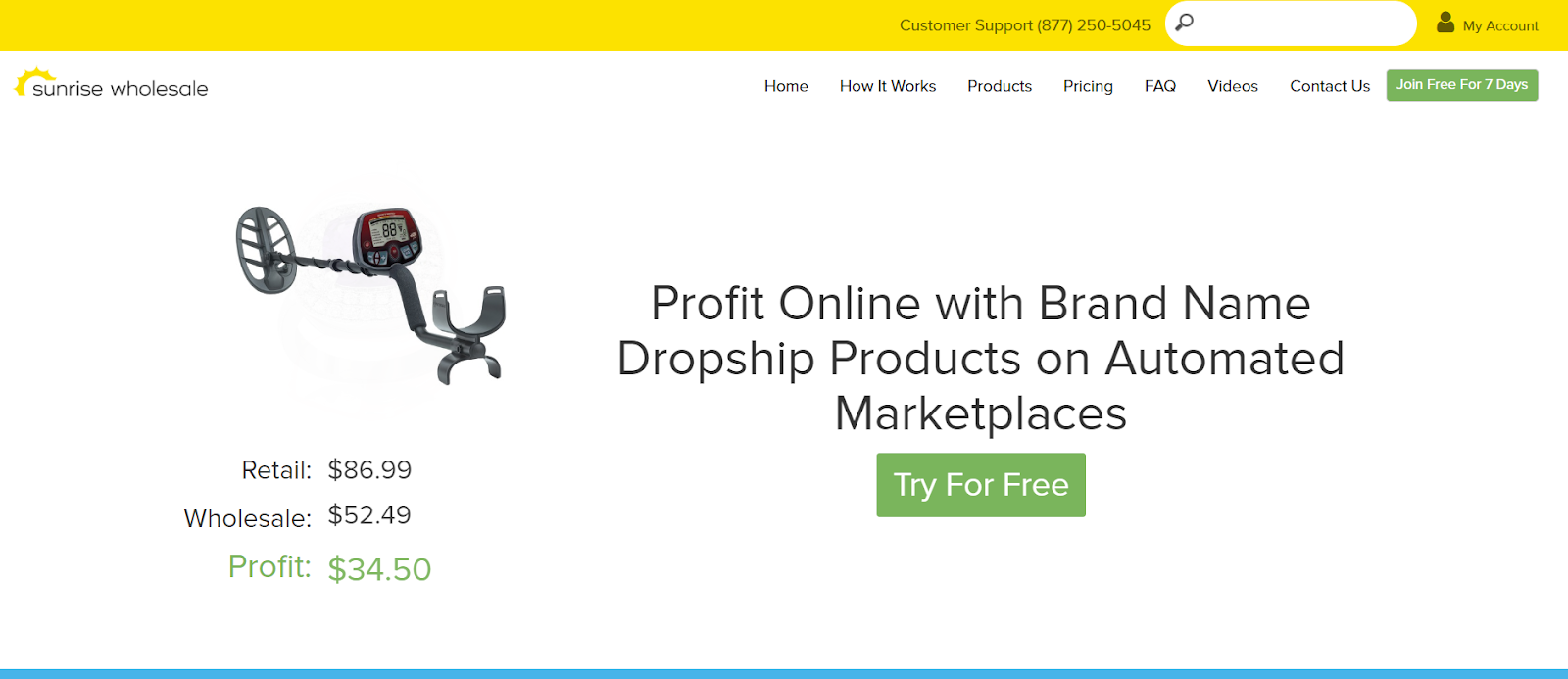
Sunrise Wholesale is a USA dropshipping supplier with integration capabilities for Amazon and eBay.
Offering a large inventory of approximately 20,000 products, from electronics to home décor, Sunrise Wholesale operates from California, ensuring quick order processing.
Their services come at a monthly fee of $49 or a one-week free trial.
BigBuy

BigBuy is a wholesale and dropshipping supplier offering a wide range of items across categories.
Focused on e-commerce, BigBuy collaborates with online merchants, providing access to thousands of items at affordable prices.
Doba
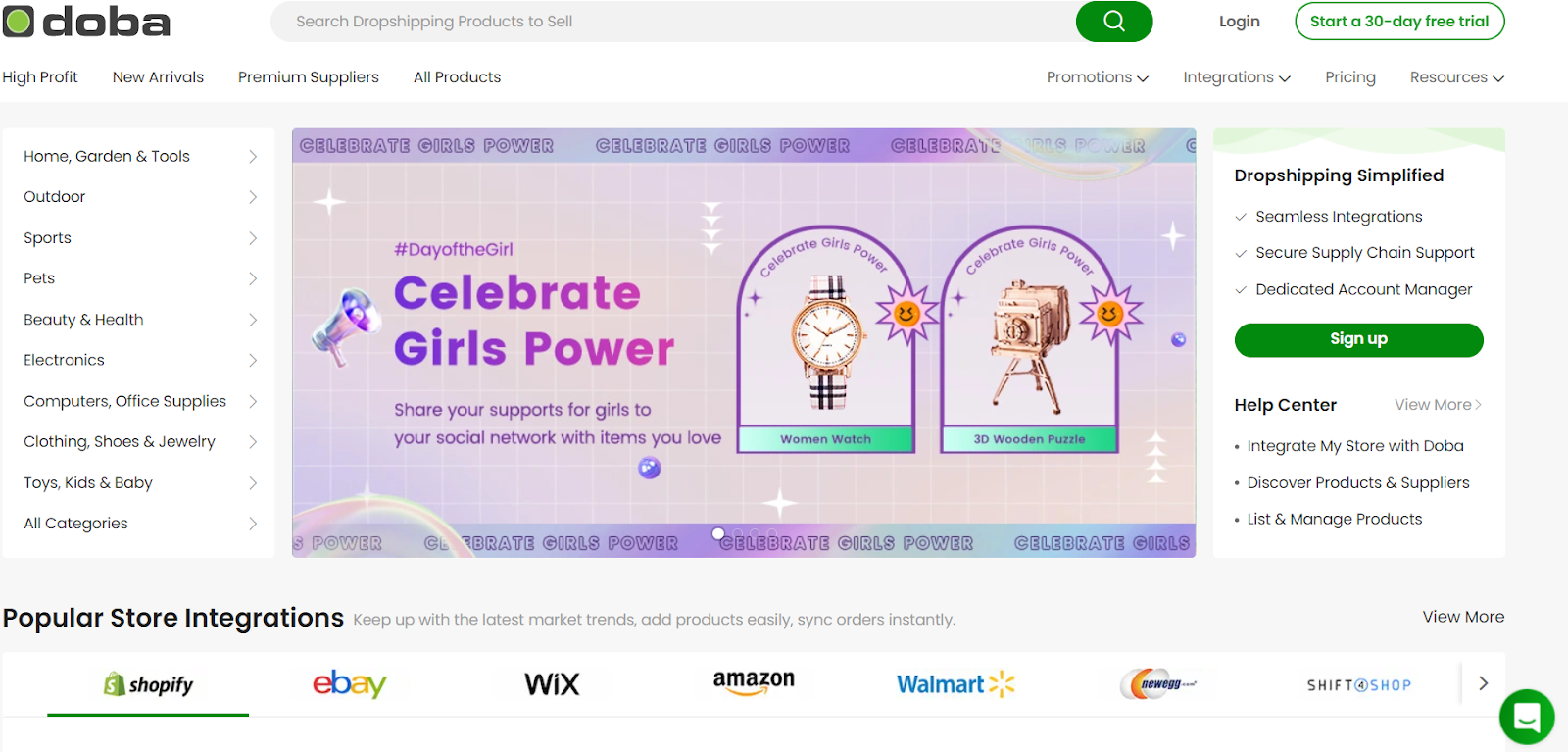
Doba is one of the largest US dropshipping suppliers, offering a vast selection of items across various categories.
With an easy connection to their inventory, Doba provides a 30-day trial period and offers different pricing plans based on the volume of inventory, staff assistance, account management, and premium data reports.
How To Start Dropshipping As A Beginner? My Process
So, as you learn how does dropshipping work, now I will show you my process of starting out.
Step 1 – Selecting a Dropshipping Niche
Firstly, identify the dropshipping niche you want to explore for selling. Will you focus on a single product store, or do you prefer dropshipping a variety of art-related items?
This could include fitness products, clothing, home decor, or any other category you’re passionate about and believe has a market demand.
For example, if you’re interested in dropshipping wall art, use tools like Google Trends to check for product demand and interest over time.
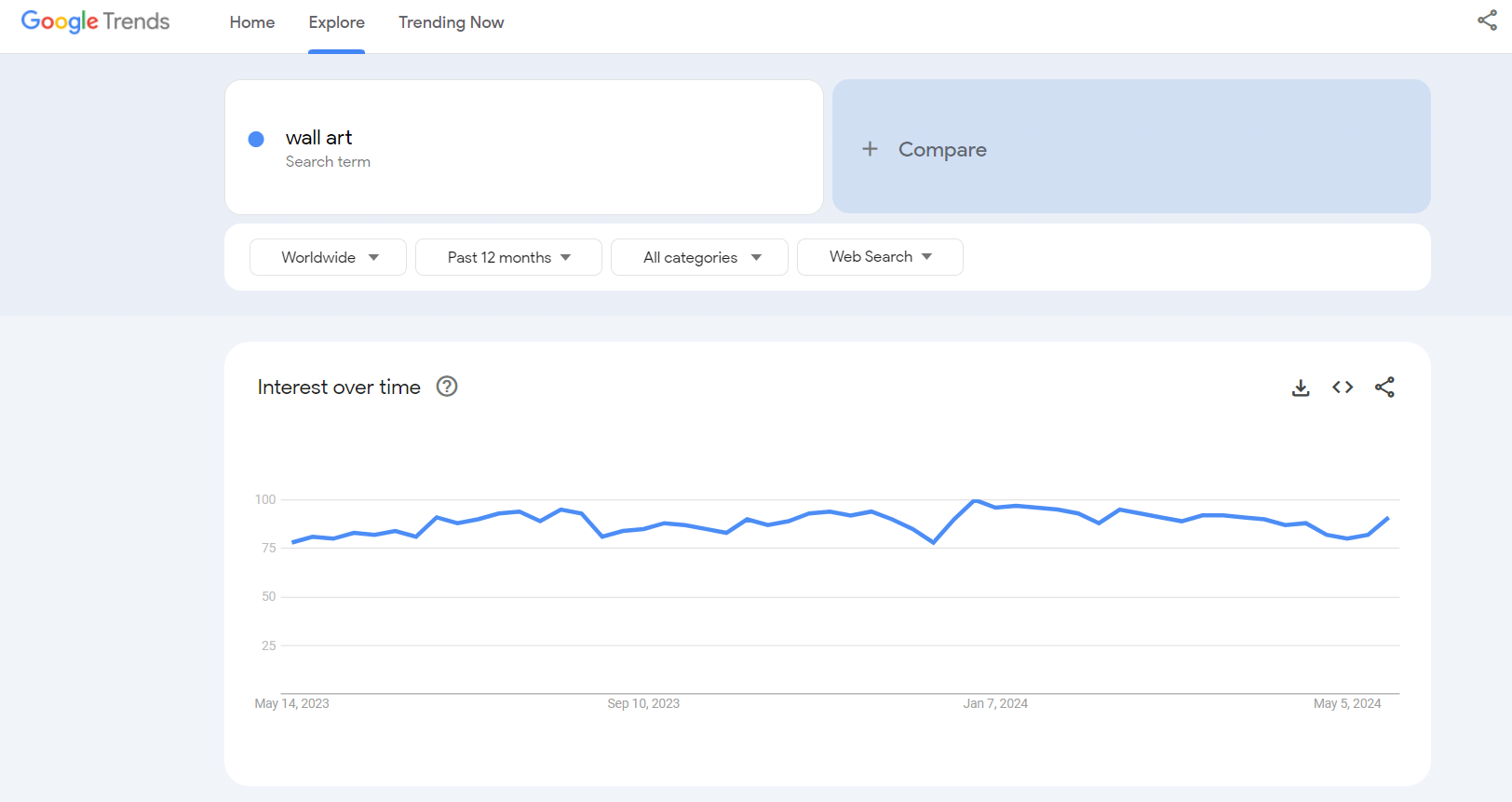
Additionally, tools like Minea can help identify winning products by monitoring social media advertisements and providing insights into popular purchases.
Step 2- Find Your Dropshipping Products
The next crucial step is to source your dropshipping products from reliable suppliers. Avoiding scams is important to prevent financial losses.
Find suppliers that offer the products you want and establish partnerships or agreements with them for a steady supply of inventory.
For instance, platforms like Dropshipping.com provide a directory of over 2000 trustworthy suppliers, allowing you to refine your search based on your dropshipping niche, supplier location, shipping costs, and other criteria.

Access valuable information about each supplier, such as pricing, order processing time, minimum order quantity (MOQ), warehouse location, product range, and more.
Step 3 – Set Up Your Dropshipping Store
Next step requires you to create your dropshipping store, ensuring visually appealing and easy-to-navigate landing pages.
In fact, as I already explained the importance for this in my “how does dropshipping work” guide, this is your doorstep or the place where you sell your products. So, you must make sure it is easy to navigate and eye-catching.
Thankfully, various website builders are available, with Shopify being a top choice due to its user-friendly interface, wide range of visually appealing themes (both paid and free), and customizable features.
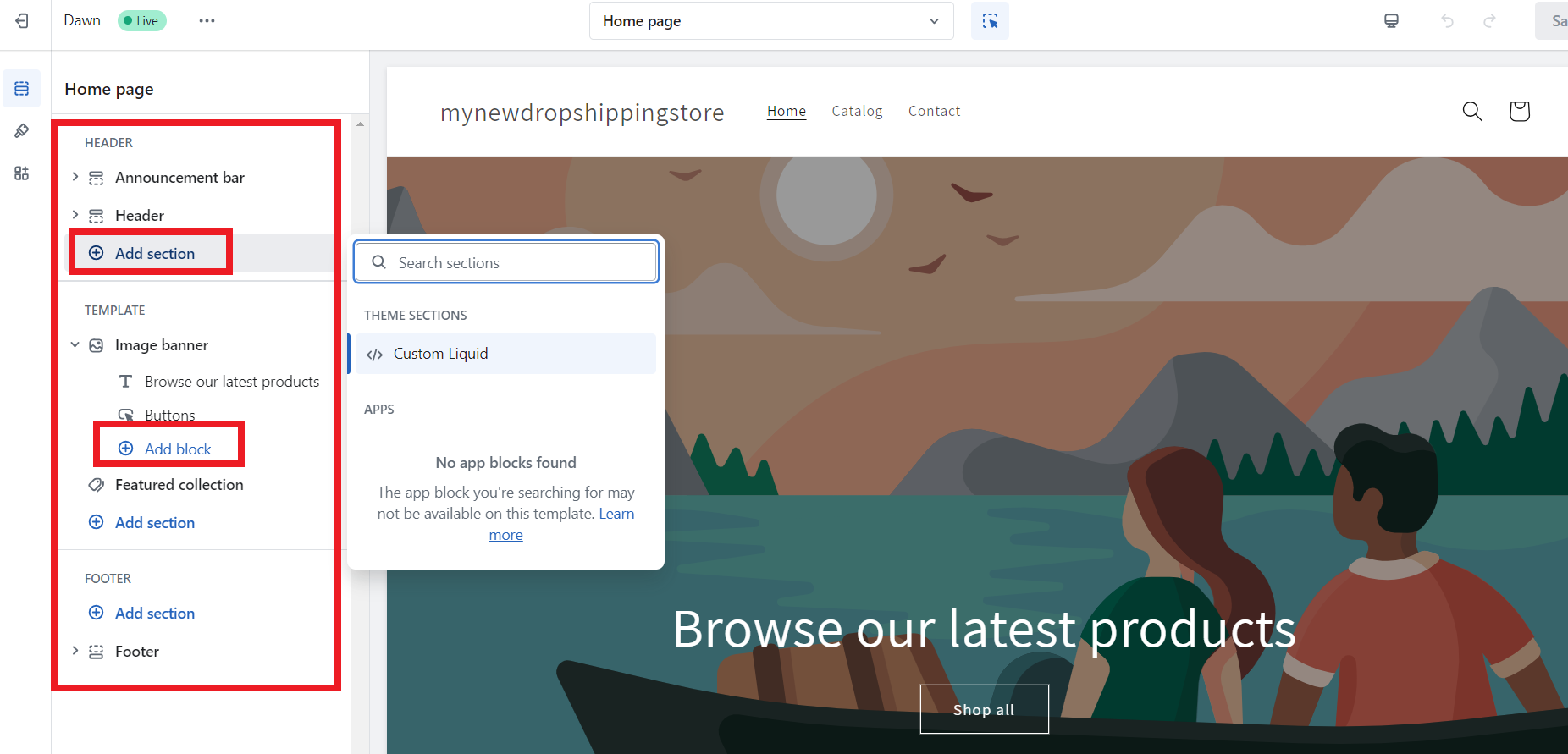
The drag-and-drop editor simplifies store creation and modification. Shopify also integrates seamlessly with dropshipping apps, enabling automated supply chain processes.
Step 4- Implement Marketing Strategies
Next, utilize digital marketing techniques to drive traffic to your online store. Consider implementing a search engine optimization strategy , social media marketing, email marketing, and paid advertising.
Also, you can boost sales through strategies like cross-selling, up-selling, providing discount codes, etc. Moreover, you can use video marketing to better showcase your dropshipping products.
Step 5 – Streamline Customer Support
Lastly, make sure you offer excellent customer support, as customers want to be heard and are not very patient. Hence, you know how dropshipping work, so you know how important this is.
So, ensure 24/7 support and provide various communication channels such as email, social media, phone calls, and chatbots to cater to different customer preferences.
Other Things To Consider When Learning How Does Dropshipping Work?
1. Website Operation
You don’t have to be a tech genius to set up and sell your products online. However, it’s still very useful to get some basic knowledge of setting up a website.
This especially applies when you need to operate it and use it to its full potential.
Thus, having general knowledge of how websites work can save you a lot of trouble in the future when you have to solve problems with your website and find information about how to do that effectively.
Therefore, read How to Build an Ecommerce Website from Scratch – My Process.
Here I share the best predictions: What is the future of dropshipping?
2. Domain Name Pricing Systems
Getting a website is not free, you will be charged for your domain name. There are many different platforms where you can register your domain name, for which they’d charge yearly for using it.
Make sure to remember the price that you see on the platform, because it may not always be the price that is charged regularly. So, read the terms and conditions carefully so as to not be surprised when you’re charged more for using the same services.
Some platforms charge an introductory price first and in time, move to their regular price. It is always better to contact the platform and have them explain their pricing to you.
If the provider doesn’t charge an introductory price don’t be afraid to ask them if they can do it. Introductory rates are not bad, but they can surprise you if you are unaware of your platform’s pricing strategies.
It’s important to know this information to understand how does dropshipping work.
👉 Check out the 8 Best GoDaddy Alternatives For E-Shop Hosting In 2024.
3. Negotiating With Suppliers
When you start working with suppliers, you should know that the prices listed on their websites are almost always negotiable.
When the time comes to ask for discounts, find someone in a position of authority who can grant such requests.
Otherwise, you will probably just waste your time. However, you shouldn’t ask for discounts as soon as you start working with a new supplier.
In fact, this won’t be a good beginning to a new business relationship. Making vendors trust you is the main reason why they’d be willing to give you bigger discounts.
The discounts that suppliers give you are not there to beat your competition and provide lower prices on the market. It is a way for you to make more revenue.
If you do not build a relationship of trust with your supplier they will be hesitant to give you larger discounts, because they will be worried that you will let other drop shippers know about the possibility of such discounts or that you will lower the retail price of the item, which is in no one’s interests. If they see that you use discounts provided to you wisely they will continue giving you discounts.
👉 Learn How To Connect a Dropshipping Supplier to Your Store?
4. Website Downtime
This is yet another important thing to know about, whenever you ask yourself ‘how does dropshipping work’. One of the rarely considered things when choosing a domain provider is how much uptime they can ensure.
And the performance of the website is detrimental to your business’s success.
However, you need to remember that no host can guarantee 100% uptime. There are many factors that can make a website go down and not all of them can be controlled.
Four major reasons for a website to be down/offline are programming errors, planned downtime, natural disasters, and viruses.
Planned downtime is when the provider has some upgrades to do.
Once the software or hardware is upgraded, the website will be back up and running.
Sometimes programming errors, or as they are commonly known as “bugs” or viruses may cause the website to become unavailable/unstable.
Any natural disasters such as fires or earthquakes can cause damage to the hardware your host uses. This will most likely cause your website to go down.
If the website is down for a long time, it will have a negative impact on your online business. Moreover, it can hurt your SEO rating. Your customers won’t be happy and you can expect sales to drop.
You cannot control your website downtime, but you can find a quality provider to avoid it as much as possible.
FAQs- How Does Dropshipping Work?
1. Is dropshipping legal?
Yes, dropshipping is completely legal and involves conducting business without any illegal activities. However, dropshippers need to follow local laws, get necessary licenses, and comply with regulations.
2. Is dropshipping profitable?
Certainly! When done right, dropshipping can be a profitable venture.
Recent dropshipping stats suggest the global dropshipping industry is expected to reach $301.11 billion in 2024, with projections to hit $500 billion by 2027.
3. What are some dropshipping product ideas?
Dropshipping offers a wide range of product options, including clothing, home decor, beauty products, electronics, and reselling sneakers.
Also, product research tools like AutoDS, Adserea, Sell The Trend, or Minea can help identify emerging markets like eco-friendly products, pet supplies, or fitness equipment.
4. Do I need to register a business entity to dropship?
Yes, it’s generally recommended to register a business entity before starting a dropshipping business.
So, when it comes to how does dropshipping work, this involves steps like choosing a business name, deciding on a business structure, registering with authorities, obtaining an EIN, and complying with regulations.
Also, consult with a professional to ensure compliance.
👉 Discover Do I Need an LLC For Dropshipping? The Sellers Guide.
5. Is Dropshipping Dead?
No, dropshipping is far from dead. It’s thriving and expected to reach $301.11 billion in 2024. Google Trends and global eCommerce market size statistics confirm its continued growth, proving that the dropshipping business model is very much alive.
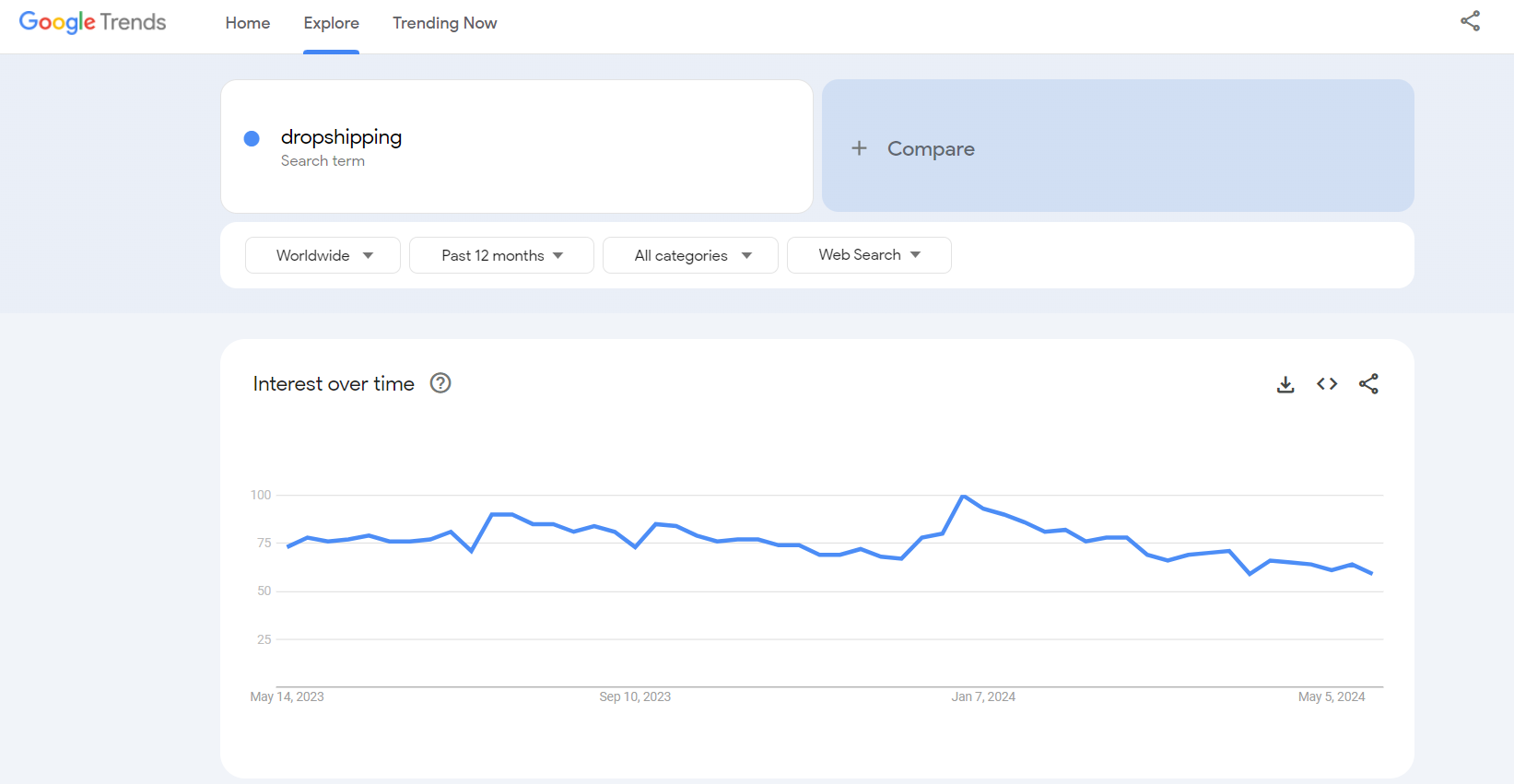
👉 Read more about Is Dropshipping Dead In 2024: Is It Too Late To Start Now?
6. Can I Get Rich With Dropshipping?
Yes, dropshipping is a low-risk, highly profitable model that can become a full-time income source. Success, however, requires developing skills in areas like copywriting and paid advertising. While getting rich quickly is challenging, it’s possible with patience and the right approach.
Check out the Top 11 Richest Dropshipping Store Owners In The World.
7. Can I Start Dropshipping With No Money?
Yes, it’s possible to start with no money initially, but you may need to invest later.
So, you can use the free trials of website builders like Shopify, find free dropshipping suppliers on platforms like Dropshipping.com or Aliexpress, and advertise for free through SEO strategies.
Thus, that’s how dropshipping work with no money.
👉 Check out the Free Dropship Websites: Start Dropshipping With $0.
8. How to Create My Dropshipping Store?
You have three ways to build a dropshipping store: hire a developer, use an open-source system like WordPress, or use a website builder like Shopify. Follow these quick steps:
- Sign up for Shopify
- Choose a plan
- Customize your store
- Add products
- Set up payment and shipping
- Launch your store
👉 Learn How To Set Up Your First Store On Shopify [No.1 Beginners Guide].
9. Can I Start a Dropshipping Business As a Teen?
Absolutely! Teens can start a dropshipping store, but challenges may arise due to the lack of a personal bank account or ID for verification. A workaround is to use a parent’s or older sibling’s bank account for transactions.
However, it is advisable to first learn how does dropshipping work.
👉 Read about Dropshipping for Students – Starting a Business from College.
👉 Read about How Old Do You Have To Be To Dropship? A Guide For Age 15, 16, 17, 18.
10. What Is The Average Dropshipping Profit Margin?
The average dropshipping profit margin ranges from 15% to 20%. However, this may vary from one to another dropshipping niche.


How Does Dropshipping Work?
This is a basic explanation of how dropshipping works.
If you’d like to know more about dropshipping and its latest trends, and dropshipping suppliers, I suggest you join our community completely for free and learn from like-minded people, and mentors alongside all necessary dropshipping resources and apps.













![The Top 21 3PL Companies Compared [2024 List & Guide]](https://images.weserv.nl/?url=https://prod-dropshipping-s3.s3.fr-par.scw.cloud/2024/03/Frame-3922469.jpg&w=420&q=90&output=webp)